
Evolution is the change in the heritable characteristics of biological populations over successive generations. It occurs when evolutionary processes such as natural selection and genetic drift act on genetic variation, resulting in certain characteristics becoming more or less common within a population over successive generations. The process of evolution has given rise to biodiversity at every level of biological organisation.
Macroevolution comprises the evolutionary processes and patterns which occur at and above the species level. In contrast, microevolution is evolution occurring within the population(s) of a single species. In other words, microevolution is the scale of evolution that is limited to intraspecific (within-species) variation, while macroevolution extends to interspecific (between-species) variation. The evolution of new species (speciation) is an example of macroevolution. This is the common definition for 'macroevolution' used by contemporary scientists. Although, the exact usage of the term has varied throughout history.
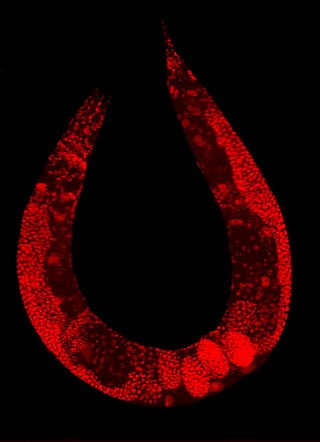
A multicellular organism is an organism that consists of more than one cell, unlike unicellular organisms. All species of animals, land plants and most fungi are multicellular, as are many algae, whereas a few organisms are partially uni- and partially multicellular, like slime molds and social amoebae such as the genus Dictyostelium.
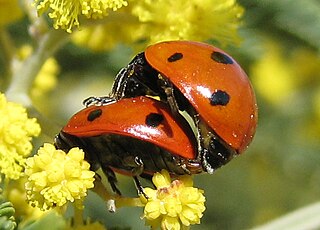
Evolution of sexual reproduction describes how sexually reproducing animals, plants, fungi and protists could have evolved from a common ancestor that was a single-celled eukaryotic species. Sexual reproduction is widespread in eukaryotes, though a few eukaryotic species have secondarily lost the ability to reproduce sexually, such as Bdelloidea, and some plants and animals routinely reproduce asexually without entirely having lost sex. The evolution of sexual reproduction contains two related yet distinct themes: its origin and its maintenance. Bacteria and Archaea (prokaryotes) have processes that can transfer DNA from one cell to another, but it is unclear if these processes are evolutionarily related to sexual reproduction in Eukaryotes. In eukaryotes, true sexual reproduction by meiosis and cell fusion is thought to have arisen in the last eukaryotic common ancestor, possibly via several processes of varying success, and then to have persisted.
Experimental evolution is the use of laboratory experiments or controlled field manipulations to explore evolutionary dynamics. Evolution may be observed in the laboratory as individuals/populations adapt to new environmental conditions by natural selection.
Evolvability is defined as the capacity of a system for adaptive evolution. Evolvability is the ability of a population of organisms to not merely generate genetic diversity, but to generate adaptive genetic diversity, and thereby evolve through natural selection.
Peter G. Schultz is an American chemist. He is the CEO and Professor of Chemistry at The Scripps Research Institute, the founder and former director of GNF, and the founding director of the California Institute for Biomedical Research (Calibr), established in 2012. In August 2014, Nature Biotechnology ranked Schultz the #1 top translational researcher in 2013.
Exaptation or co-option is a shift in the function of a trait during evolution. For example, a trait can evolve because it served one particular function, but subsequently it may come to serve another. Exaptations are common in both anatomy and behaviour.
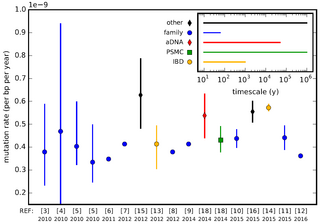
In genetics, the mutation rate is the frequency of new mutations in a single gene, nucleotide sequence, or organism over time. Mutation rates are not constant and are not limited to a single type of mutation; there are many different types of mutations. Mutation rates are given for specific classes of mutations. Point mutations are a class of mutations which are changes to a single base. Missense, nonsense, and synonymous mutations are three subtypes of point mutations. The rate of these types of substitutions can be further subdivided into a mutation spectrum which describes the influence of the genetic context on the mutation rate.

Richard E. Lenski is an American evolutionary biologist, the John A. Hannah Distinguished Professor of Microbial Ecology at Michigan State University. He is a member of the National Academy of Sciences and a MacArthur Fellow. Lenski is best known for his still ongoing 36-year-old long-term E. coli evolution experiment, which has been instrumental in understanding the core processes of evolution, including mutation rates, clonal interference, antibiotic resistance, the evolution of novel traits, and speciation. He is also well known for his pioneering work in studying evolution digitally using self-replicating organisms called Avida.

Directed evolution (DE) is a method used in protein engineering that mimics the process of natural selection to steer proteins or nucleic acids toward a user-defined goal. It consists of subjecting a gene to iterative rounds of mutagenesis, selection and amplification. It can be performed in vivo, or in vitro. Directed evolution is used both for protein engineering as an alternative to rationally designing modified proteins, as well as for experimental evolution studies of fundamental evolutionary principles in a controlled, laboratory environment.
Adaptive mutation, also called directed mutation or directed mutagenesis is a controversial evolutionary theory. It posits that mutations, or genetic changes, are much less random and more purposeful than traditional evolution, implying that organisms can respond to environmental stresses by directing mutations to certain genes or areas of the genome. There have been a wide variety of experiments trying to support the idea of adaptive mutation, at least in microorganisms.
The Red Queen's hypothesis is a hypothesis in evolutionary biology proposed in 1973, that species must constantly adapt, evolve, and proliferate in order to survive while pitted against ever-evolving opposing species. The hypothesis was intended to explain the constant (age-independent) extinction probability as observed in the paleontological record caused by co-evolution between competing species; however, it has also been suggested that the Red Queen hypothesis explains the advantage of sexual reproduction at the level of individuals, and the positive correlation between speciation and extinction rates in most higher taxa.

The E. coli long-term evolution experiment (LTEE) is an ongoing study in experimental evolution begun by Richard Lenski at the University of California, Irvine, carried on by Lenski and colleagues at Michigan State University, and currently overseen by Jeffrey Barrick at the University of Texas at Austin. It has been tracking genetic changes in 12 initially identical populations of asexual Escherichia coli bacteria since 24 February 1988. Lenski performed the 10,000th transfer of the experiment on March 13, 2017. The populations reached over 73,000 generations in early 2020, shortly before being frozen because of the COVID-19 pandemic. In September 2020, the LTEE experiment was resumed using the frozen stocks. When the populations reached 75,000 generations, the LTEE was transferred from the Lenski lab to the Barrick lab. In August 2024, the LTEE populations passed 80,000 generations in the Barrick lab.
Microorganisms engage in a wide variety of social interactions, including cooperation. A cooperative behavior is one that benefits an individual other than the one performing the behavior. This article outlines the various forms of cooperative interactions seen in microbial systems, as well as the benefits that might have driven the evolution of these complex behaviors.

Allorecognition is the ability of an individual organism to distinguish its own tissues from those of another. It manifests itself in the recognition of antigens expressed on the surface of cells of non-self origin. Allorecognition has been described in nearly all multicellular phyla.

Evolving digital ecological networks are webs of interacting, self-replicating, and evolving computer programs that experience the same major ecological interactions as biological organisms. Despite being computational, these programs evolve quickly in an open-ended way, and starting from only one or two ancestral organisms, the formation of ecological networks can be observed in real-time by tracking interactions between the constantly evolving organism phenotypes. These phenotypes may be defined by combinations of logical computations that digital organisms perform and by expressed behaviors that have evolved. The types and outcomes of interactions between phenotypes are determined by task overlap for logic-defined phenotypes and by responses to encounters in the case of behavioral phenotypes. Biologists use these evolving networks to study active and fundamental topics within evolutionary ecology.
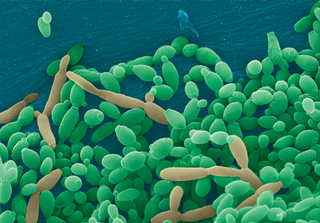
Candida tropicalis is a species of yeast in the genus Candida. It is a common pathogen in neutropenic hosts, in whom it may spread through the bloodstream to peripheral organs. For invasive disease, treatments include amphotericin B, echinocandins, or extended-spectrum triazole antifungals.
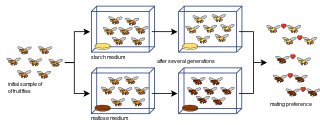
Laboratory experiments of speciation have been conducted for all four modes of speciation: allopatric, peripatric, parapatric, and sympatric; and various other processes involving speciation: hybridization, reinforcement, founder effects, among others. Most of the experiments have been done on flies, in particular Drosophila fruit flies. However, more recent studies have tested yeasts, fungi, and even viruses.
Albert Farrell Bennett is an American zoologist, physiologist, evolutionary biologist, author, and academic. He is Dean Emeritus of the School of Biological Sciences at University of California, Irvine.













